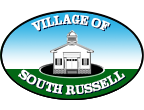This page is intended to provide information about the South Russell Phase II Stormwater Management Program. Additional information in the form of publications and literature made available to South Russell Village is also provided.
2021 Master Storm Water Study Update
Top 10 Facts About Groundwater Use
- Only 1 percent of the water on Earth is useable, 99 percent of which is groundwater.
- The United States uses 349 billion gallons of freshwater every day.
- Groundwater is 20 to 30 times larger than all U.S. lakes, streams, and rivers combined.
- Groundwater accounts for 33 percent of all the water used by U.S. municipalities.
- 44 percent of the U.S. population depends on groundwater for its drinking water supply.
- More than 13.2 million households have their own well, representing 34 million people.
- 53.5 billion gallons of groundwater are used for agricultural irrigation each day. In 1990 that number was 2.2 billion.
- The largest U.S. aquifer is Ogallala, underlying 250,000 square miles stretching from Texas to South Dakota. Scientists estimate it could take 6000 years to naturally refill the aquifer if it were ever fully depleted.
- California pumps 10.7 billion gallons of groundwater each day, a third more than the second-highest state, Texas.
- Groundwater is the world’s most extracted raw material with withdrawal rates in the estimated range of 259 trillion gallons per year.
Top Groundwater Myths
- Groundwater migrates thousands of miles.
- Groundwater removed from the Earth is never returned.
- Groundwater is not a significant source of water supply.
- Groundwater is abundantly available, therefore does not need to be conserved.
- There is no relationship between groundwater and surface water.
Further reading
- Educators Experience the “Wonders of Watersheds”
- Household Habits for Healthy Waters
- There’s No Match for a Native Plant Patch
Innovative Stormwater Management Project
View the Stormwater Management Project Video (make sure your sound is turned on and up) of the installation of stormwater management best management practices – such as pervious pavement, vegetated swale, and rain garden for a small office building in Northeast Ohio.
What is a “Watershed”?
View the What is a Watershed? Video (make sure your sound is turned on and up) and see if your answer is the same as others.
Rain, Drains and you
Where does our water go? All the water we use inside our homes goes directly to the septic system or to a sanitary sewer system and then to a wastewater treatment plant where it is cleaned and released back into our creeks, streams and lakes cleaner than when it started.
What about all the water outside of our homes such as the rainwater that falls on our roofs, lawns, driveways, roads, streets, roadside ditches and parking lots? Where does this water go? It is not always easy to tell where this “STORMWATER” goes after it gets to the gutter, storm drain, street or ditch. The stormwater flows from these places to our creeks, streams, and lakes, BUT IS NOT CLEANED before it gets there.
The rainwater from our roofs, gutters, lawns, driveways, parking lots, roads, and roadside ditches picks up trash and pollution. This pollution includes oil and antifreeze that drips from our cars, excess fertilizer and pesticides from our lawns, litter, grass clippings, leaves, and pet waste. Once pollution is picked up by the rainwater it moves through gutters, storm sewers and ditches to our creeks, streams, and lakes where it can cause health and safety problems for us and the living things in them.
Because we live on or near Lake Erie, and most of Northeast Ohio’s rainwater flows from creeks and streams to the Lake, we not only affect the health our creeks, but the health of our Lake, its beaches, and our drinking water supply.
Rainwater from roofs, lawns, driveways, streets, roadside ditches and parking lots in South Russell drain to small creeks that flow into the Chagrin River and then to Lake Erie. This rainwater has a direct impact on some of our greatest assets in these areas. There are many ways we can help keep our water clean, save money, and prevent problems. It is important that we work together to keep our creeks and streams healthy.
South Russell is working to make sure that creeks and streams running through our community are clean and free of pollutants to help keep them, the Chagrin River, the Chagrin River watershed, and Lake Erie watershed, a healthy place for our use and enjoyment.
So, we not only affect the health our creeks, but the health of our Lake, its beaches, and our drinking water.
Additional links for selected topics with additional and useful information:

